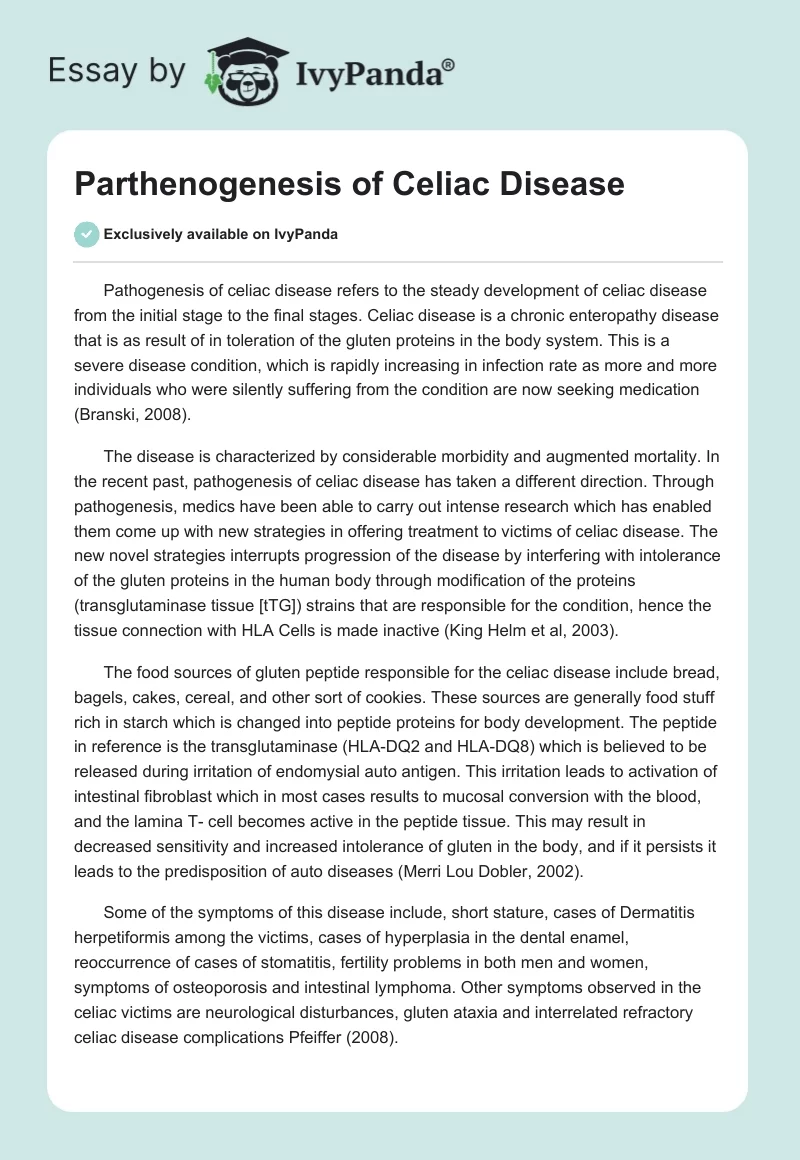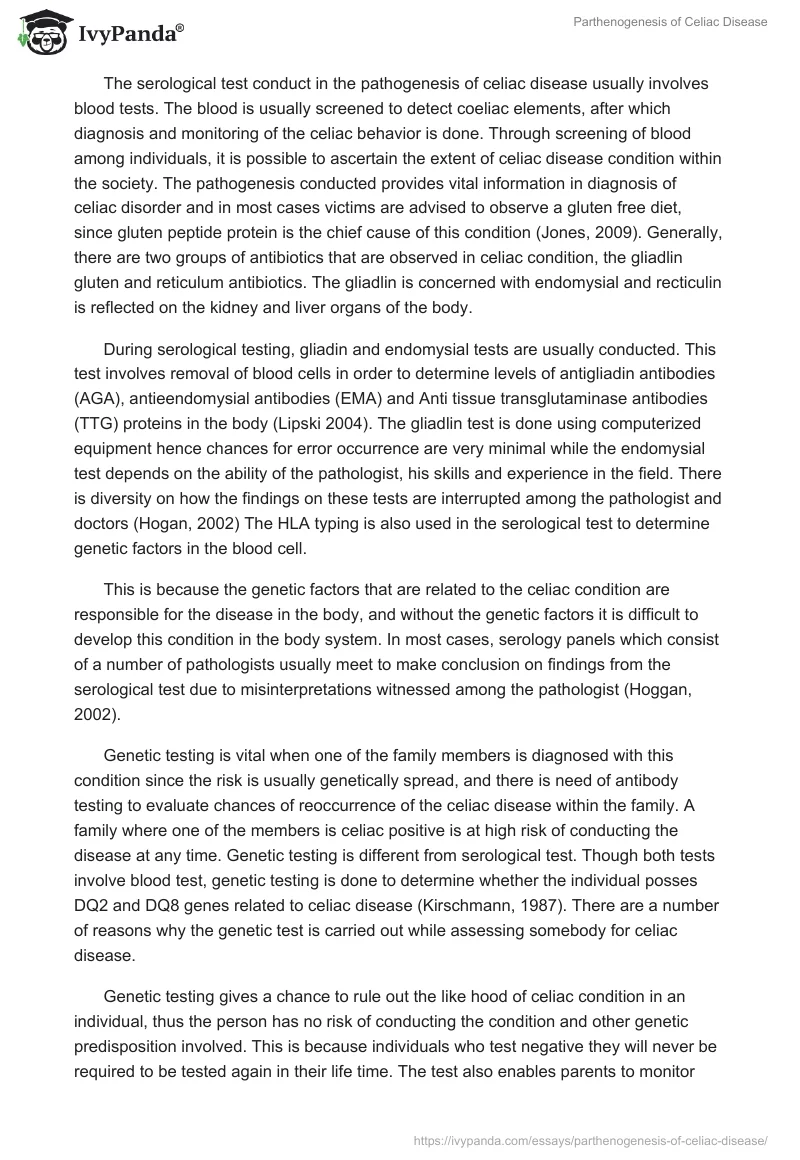Pathogenesis of celiac disease refers to the steady development of celiac disease from the initial stage to the final stages. Celiac disease is a chronic enteropathy disease that is as result of in toleration of the gluten proteins in the body system. This is a severe disease condition, which is rapidly increasing in infection rate as more and more individuals who were silently suffering from the condition are now seeking medication (Branski, 2008).
The disease is characterized by considerable morbidity and augmented mortality. In the recent past, pathogenesis of celiac disease has taken a different direction. Through pathogenesis, medics have been able to carry out intense research which has enabled them come up with new strategies in offering treatment to victims of celiac disease. The new novel strategies interrupts progression of the disease by interfering with intolerance of the gluten proteins in the human body through modification of the proteins (transglutaminase tissue [tTG]) strains that are responsible for the condition, hence the tissue connection with HLA Cells is made inactive (King Helm et al, 2003).
The food sources of gluten peptide responsible for the celiac disease include bread, bagels, cakes, cereal, and other sort of cookies. These sources are generally food stuff rich in starch which is changed into peptide proteins for body development. The peptide in reference is the transglutaminase (HLA-DQ2 and HLA-DQ8) which is believed to be released during irritation of endomysial auto antigen. This irritation leads to activation of intestinal fibroblast which in most cases results to mucosal conversion with the blood, and the lamina T- cell becomes active in the peptide tissue. This may result in decreased sensitivity and increased intolerance of gluten in the body, and if it persists it leads to the predisposition of auto diseases (Merri Lou Dobler, 2002).
Some of the symptoms of this disease include, short stature, cases of Dermatitis herpetiformis among the victims, cases of hyperplasia in the dental enamel, reoccurrence of cases of stomatitis, fertility problems in both men and women, symptoms of osteoporosis and intestinal lymphoma. Other symptoms observed in the celiac victims are neurological disturbances, gluten ataxia and interrelated refractory celiac disease complications Pfeiffer (2008).
The serological test conduct in the pathogenesis of celiac disease usually involves blood tests. The blood is usually screened to detect coeliac elements, after which diagnosis and monitoring of the celiac behavior is done. Through screening of blood among individuals, it is possible to ascertain the extent of celiac disease condition within the society. The pathogenesis conducted provides vital information in diagnosis of celiac disorder and in most cases victims are advised to observe a gluten free diet, since gluten peptide protein is the chief cause of this condition (Jones, 2009). Generally, there are two groups of antibiotics that are observed in celiac condition, the gliadlin gluten and reticulum antibiotics. The gliadlin is concerned with endomysial and recticulin is reflected on the kidney and liver organs of the body.
During serological testing, gliadin and endomysial tests are usually conducted. This test involves removal of blood cells in order to determine levels of antigliadin antibodies (AGA), antieendomysial antibodies (EMA) and Anti tissue transglutaminase antibodies (TTG) proteins in the body (Lipski 2004). The gliadlin test is done using computerized equipment hence chances for error occurrence are very minimal while the endomysial test depends on the ability of the pathologist, his skills and experience in the field. There is diversity on how the findings on these tests are interrupted among the pathologist and doctors (Hogan, 2002) The HLA typing is also used in the serological test to determine genetic factors in the blood cell.
This is because the genetic factors that are related to the celiac condition are responsible for the disease in the body, and without the genetic factors it is difficult to develop this condition in the body system. In most cases, serology panels which consist of a number of pathologists usually meet to make conclusion on findings from the serological test due to misinterpretations witnessed among the pathologist (Hoggan, 2002).
Genetic testing is vital when one of the family members is diagnosed with this condition since the risk is usually genetically spread, and there is need of antibody testing to evaluate chances of reoccurrence of the celiac disease within the family. A family where one of the members is celiac positive is at high risk of conducting the disease at any time. Genetic testing is different from serological test. Though both tests involve blood test, genetic testing is done to determine whether the individual posses DQ2 and DQ8 genes related to celiac disease (Kirschmann, 1987). There are a number of reasons why the genetic test is carried out while assessing somebody for celiac disease.
Genetic testing gives a chance to rule out the like hood of celiac condition in an individual, thus the person has no risk of conducting the condition and other genetic predisposition involved. This is because individuals who test negative they will never be required to be tested again in their life time. The test also enables parents to monitor their children’s conditions. The probability of a child inheriting the condition from the parent is very high, hence a parent suffering from the condition need to take their children for testing to determine which child is at a risk of conducting celiac disease and which one is not (Marsh, 2000).
Though positive testing does not mean that the person has the disease, monitoring the condition is recommended at any time since the likelihood of conducting the disease is high. This is because the genetic genes present in the blood cell place the person at a risky state of celiac condition.
During the genetic test, other several tests are also carried out and they include tissue transglutaminase test (tTG), and antiendomysial (EMA) antibody test. These tests are intended to measure the levels of autoimmune reaction activated by the protein gluten peptide that appears at a point within the body system. The tests also characterizes the degree at which the body immune system will respond to conditions of celiac condition, just like in serological test where the HLA typing is used to determine genetic factors within the blood. In genetic testing, HLA typing test is done to evaluate the absence or presence of genetic elements in the blood cells.
From research, a child is either born having gluten genes or not and this condition does not change in life time (Marsh, 2000). Genetic predispositions for celiac disease are inherited differently from one family to another, and are different in the way they are inherited from genetic traits. Inheritance of DQ2 and DQ8 does not cause the condition; they need to be inherited in double dose in order to cause celiac disease.
Moreover, it is possible for people having these genes to marry each without developing the disease after marriage, and can also able to give birth to children without the disease. (Fasano, 2003) The gluten can be spread by both the males and the females hence a test conducted on one person does not mean that the other side of the family has the same result. In deed genetic testing is an expensive affair and varies across the continent depending on what the gastroenterologist orders to be done. In addition, there are other expenses incurred in insurance before the test is done.
The immune-genetics of the celiac disease depends upon the genetic set up of the body which is hereditary. Families with weak immune pass the same to their offspring hence in case of celiac development in the body, the body cannot resist since the gluten gene cannot be suppressed by the body system (King Helm et al, 2003). Though there are other ways of improving the immunogentic of the body, i.e. through taking regulated food diet that is reach in body immune element such as vitamins and other essential proteins, that interfere with intolerance of gluten peptide protein in the body system, the gluten peptide as mentioned is responsible in the development of celiac condition within human beings.
Further, the environment also affects the immunogenetic system of the body. Environmental climate factors such as temperature, atmosphere pressure among others affect body system conditions that in turn influence the body system performance. Optimum environment conditions are recommended for effective immunology body system, though this varies in relation to the genetic structure of the body cells and tissues (Rudnick, 1986).
Presently, there are researches being studied across the continents aimed at reducing the essence of dieting to celiac disease victims. These researches are still undergoing development and are expected to be applied in the near future. Some the current developments of research include; Genetic engineering, whereby, the believed sources of gluten proteins are selectively breaded to improve the immune-genetic of the body system. Moreover, there is a research being undertaken to enable victims of this disease be in position to consume gluten-containing products through a mixture of the proly end-peptidase enzyme and cysteine end peptidase that is responsible for destroying the peptide protein in the duodenum part of the digestion system (Branski, 2008).
Other researches are being carried on the pathogenesis of celiac disease in order to determine the interconnection of cell HLA-DQ2 and transglutaminase tissue with gene MICA/NKG2 whose activity is to destroy enterocytes in the blood. Some of these current researches have been successful in coming up with mitigation measures that are appropriate in solving challenges of celiac disease in the society.
In conclusion, there is a lot that should be undertaken by those affected by the disease across the world in order to prevent its impacts to the body. Generally, there should be an intensive campaign on celiac awareness. Information about gluten free diet should also be provided to the people and should be practiced on internal Adherence Factors. This will inactivate the intolerance of the gluten peptide protein in the system (King Helm et al, 2003).
Reference list
Alessio Fasano, Riccardo Trombone, D. Branski (2008) Frontiers in celiac disease Volume 12 of Pediatric and adolescent medicine. Web.
Bette Hagman (2001) More from the gluten-free gourmet: delicious dining without wheat, Publisher Henry Holt and Co.
Bette Hagman (2001) The gluten-free gourmet cooks fast and healthy: wheat-free Recipes with less fuss and fat. Publisher Henry Holt.
Eamonn M. M. Quigley, Ronald F. Pfeiffer (2008) Professional Guide to Diseaseprofessional guide to diseases. Publisher Lippincott Williams & Wilkins.
Elizabeth Lipski (2004) Digestive wellness, Publisher McGraw-Hill Professional.
James Braly, Ron Hoggan, (2002) Dangerous grains: why gluten cereal grains may be hazardous to your health, Publisher Avery.
John D. Kirschmann (1987) Nutrition Search, Inc; Nutrition Almanac nutrition almanac, Publisher McGraw-Hill.
Michael N. Marsh (2000) Celiac disease: methods and protocols Volume 41 of Methods in molecular medicine; Publisher Humana Press.
Olivier Morteau (2004) Oral tolerance: the response of the intestinal mucosa to dietaryantigens Medical intelligence unit, Publisher Springer.
Patricia Queen Samour, Carol E, Kathy King Helm (2003) Handbook of Pediatric , Publisher Jones & Bartlett Publishers.
Paul Rudnick (1986) Social Disease a Borzoi book. Publisher Knopf.
Peter H. R. Green, Rory Jones (2009) Celiac Disease: A Hidden Epidemic, Publisher HarperCollins.
Phyllis A. Balch (2002) Prescription for herbal healing, Publisher Avery.
Tricia Thompson, Merri Lou Dobler (2002) Celiac disease nutrition guide, American Dietetic Association.
Zeus Fasano (2003) Neuro-Gastroenterology, Publisher Gulf Professional Publishing.


